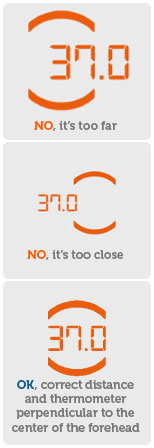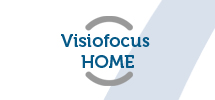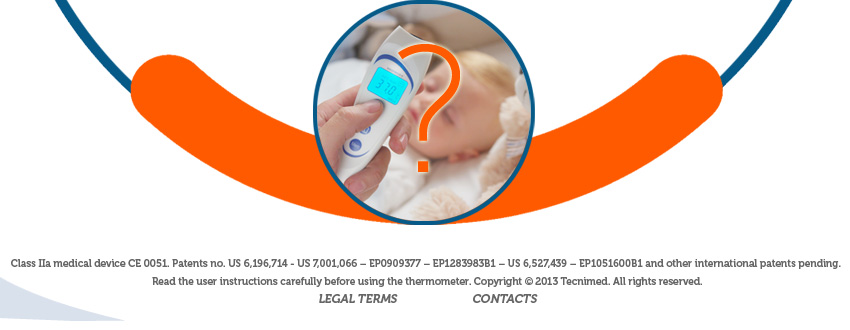What are VisioFocus®' advantages if compared to other thermometers?
VisioFocus ® is the only thermometer in the world that projects the temperature reading on the forehead, without ever coming into contact with the skin. The projection system indicates the correct reading distance, that is essential to obtain accurate measurements. As Thermofocus, VisioFocus ® is an extremely advanced thermometer. It is truly easy to use, not invasive, reliable, safe, very fast and hygienic. Moreover, there are no breaking risks, as in the case of mercury thermometers. Finally, unlike other thermometers, VisioFocus ® never coming into contact with the skin, so there is no need to disinfect it or to use hygienic protection. These features reduce in fact the risk of contaminations.
- How does VisioFocus® work?
As Thermofocus, VisioFocus® detects the infrared radiation naturally emitted by the body and, in particular, from the human forehead.. In just a few hundredths of a second your VisioFocus® takes a series of 125 readings, Its sophisticated microprocessor then amplifies and processes this information along with the room temperature, detected from a thermocouple probe incorporated within the sensor. The data are compared with the parameters contained in the memory, and the results of these processing is the temperature showed on the display.
- What is the correct reading distance?
The thermometer itself will tell you the correct reading distance, by means of its patented optical aiming system: if the thermometer is too close, or too far away from the skin, the temperature will not call between the two arches. When you see the temperature at the midpoint between the two arches, the thermometer is at the right distance for a correct reading.

- Why is it so important for the thermometer to be at the correct reading distance?
The “field of view”, where every infrared sensor works, is cone-shaped: this means that the farer you go from the surface, the bigger the cone’s base – the area of which you take the reading - becomes.
If, for example, the distance from the center of the forehead is bigger than expected, the thermometer will include in the measurement area also the temperature of the eyebrows, of the eyes or of the hair. If the distance gets even bigger, it will include the temperature of the whole face.
In all these cases, the reading temperature would not be correct as it would be an average of all the parts of the face included in the “field of view”.
- What does the different colors of the display mean?
The 5 colors of the display depend on different functions.
The display lights up in:
-light blue, when the reading is taken with the “face” button (to read the body temperature)
-green, when the reading is taken with the “home” button (to read the temperature of objects or liquids or the skin temperature of other parts of the body)
-violet, when the memory function is activated (when you press the “Mem” button twice or more times with the thermometer in stand-by)
-orange, when the display shows the ambient temperature (when the thermometer is in stand-by and you press the “Mem” button once)
-blue, when the MQCS (Manual Quick Calibration System) is activated'
- Which is VisioFocus® range of work?
VisioFocus® can operate in rooms where the temperature is between 16 to 40 °C (60.8-104°F).
The measurement range of the body temperature on the center of the forehead, using the “face” button, is between 34 and 42.5 °C (93.2/108.5 °F); using the “home” button, the measurement range is between 1 and 80°C (33.8/176°F). With the “home” button it is possible to use the thermometer also in rooms where the temperature is between 5 and 16C (41 and 60.8°F), although accuracy and the operating range are not guaranteed.
- What happens if the red lights are unintentionally directed towards the eyes?The lights are harmless. THEY ARE NOT LASER BEAMS!
- After the first measurement, how long do I have to wait before I can take another one?
With VisioFocus®, you can immediately take another reading.
- Is there any situations in which VisioFocus® should not be used in the center of the forehead?
The forehead temperature reading can be affected by profuse sweating or if an oxygen mask is present or if the subject is elderly.
In case of sweating, dry the forehead is not enough, as the low readings do not depend on the sweat drops, but on the dissipation of heat which occurs when sweating.
The oxygen masks are not hermetic and so the oxygen can make the forehead cold: the temperature reading would not be correct.
A low vascularization of the forehead may occur in elderly people.
In all the above cases, the temperature detected on the forehead will be lower than the real body temperature.
- Is there an area alternative to the center of the forehead?
We suggest to take the temperature reading again from a distance, by taking a close-up scan of the closed eyelid, using the “face ”button. No need to worry that your child could open its eyes while you are taking the reading:the lights are harmless. Otherwise, if neither the measurement on the eyelid should be possible (in case of inflammations, chirurgic operations, lachrymation – a baby’s cry – oxygen mask, wrinkles) you can take the reading on the neck: focus the thermometer near the jugular vein, approximately 2,5 cm (1 in) below an adult’s ear and 1 cm (0.4 in) below a children’s ear) and run a scan over an area of approximately 5 cm (2 in) horizontally.
Performances are not guaranteed, but such readings can be considered a valid approximation of one’s body temperature and a fever’s indicator.
- Why the measurement on the neck near the jugular vein should be considered as the last alternative?
This area could be affected by external factors such as long hair, scarves, polo neck sweater. Moreover, it could be affected by the position of the patient, for instance if he is lying on his side. In all these situations, the neck temperature would be higher and the temperature reading would be higher than the real body temperature. In such cases, we recommend to take the temperature on both sides and consider the lower one.
- Is the temperature reading detected with VisioFocus® the same as that taken with other thermometers and in other parts of the body?
The temperature reading detected with VisioFocus® is normally very similar, but not necessary equal, to the temperature taken with other thermometers. When it is set in the oral or rectal mode, the temperature is very similar respectively to the oral and the internal rectal measurement taken with other thermometers. To obtain this result, the software of VisioFocus® automatically applies a correction factor that compensates the heat dissipation from uncovered parts of the body (such as the forehead).
Moreover, the temperature differs from one area of the body to another (armpit, mouth, rectum, forehead) and that differences are not valid for everyone, but each person has his/her own body temperature:: for instance, the rectal and the oral temperature can, on some subjects, differ for less than 1°C (1.8°F), while be much more than 1°C (1.8°F) different in others.
For this reason, sometimes the forehead temperature can be different from the temperature measured in other parts of the body.
To correctly judged a fever, you need to know the normal temperature of your family members when they are in good health conditions and at various times of the day
For example, a person having a very low temperature in good health conditions will have a lower mark fever compared to others usually having a higher temperature. . To help you with this, fill out this table and keep it as a reference.
-
- Why is the forehead the ideal site for taking a temperature reading?
The forehead is crossed by the temporal artery and is the only part of the body in direct contact with the brain and that is not covered by hair. Furthermore, the head is the first part of the body to change temperature as a fever, rises and falls. This characteristic is very useful, as it can give predictive information of how the fever is changing. This is why, sometimes, it is possible to find the fever on the forehead and not in other parts of the body or viceversa. This simply means that the fever is rising or falling.
- Does the batteries’ consumption increase if VisioFocus® displays the room temperature when it is in stand-by mode?
When the thermometer remains idle for 20 seconds, it reverts to stand-by mode and will display the room temperature for 4 hours before shutting off. When it is on stand-by, even if the display stays on visualizing the room temperature, it does not remain active, which means that the consumption stays lower than that of a cell phone when not in use. The device autonomy with new batteries is of about 3 years or 10.000 measurements, depending on use.
- Can I make my VisioFocus® shut down immediately after the last use?
Depending on where it is to be sold, your thermometer leaves the factory preset with the display off when in stand-by mode (“Energy Savings”) or display on and showing the room temperature for 4 hours before shutting off (“Peak Performance”) , These settings can be modified as follows:
When the thermometer is in stand-by mode, press and hold the “mem” button; after about 8 seconds, the visualization on the display changes, showing the settings in seguence: °C, °F, AXILLA, ORAL, RECTAL, “home” on, “home” off. When the desired setting appears, release the button (“home “ on means that the display will show the ambient temperature for 4 hours before shutting off, “home” off means that it will shut down immediately after the 20 second interval after the last reading.
- Can I change the setting from oral to rectal and axilla or vice versa?
Depending on where it is to be sold, your thermometer leaves the factory referred to AXILLARY, ORAL or RECTAL temperature readings These settings can be modified as follows:
When the thermometer is in stand-by, press and hold the “mem” button; after about 8 seconds, the visualization on the display changes, showing the settings in sequence: °C, °F, AXILLA, ORAL, RECTAL. When the preferred setting appears, release the button.
After a few seconds, the thermometer will be ready for a measurement in the selected setting.
When the thermometer is set in RECTAL mode, the reading is 0.6°C (0.8°F) higher than an ORAL reading. When it is set in ORAL mode, the reading is 0.2°C (0.4°F) higher an AXILLARY reading.
- Can I change the setting from Celsius to Fahrenheit or vice versa?
Depending on where it is to be sold, your thermometer leaves the factory preset to: Celsius (°C) or Fahrenheit (°F). These settings can be modified as follows:
When the thermometer is in stand-by mode, press and hold the “mem” button; after about 8 seconds, the visualization on the display changes showing the settings in sequence: °C, °F, AXILLA, ORAL, RECTAL. When the preferred setting appears, release the button.
After a few seconds, the thermometer will be ready for a measurement in the selected setting.
- Can I use VisioFocus® even if it comes from a room having a different temperature?
All infrared thermometers must know the room temperature, and so all manufacturers suggest to wait for a certain time (usually from 10 to 30 minutes or more depending on the difference of the temperature) before using the thermometer when you come from another room at a different temperature then the room where the thermometer is used. With VisioFocus®, as Thermofocus, you do not need for waiting, thanks to 2 exclusives patented systems for quick stabilization:
the AQCS and the MQCS.
- How does the AQCS (Automatic Quick Calibration system) work?
If the thermometer is handled at length or if there is a significant temperature difference with respect to the room temperature, a countdown will appear on the display indicating that you should wait until automatic temperature calibration has been completed.without touching the thermometer, wait until the countdown has run its course and automatic quick calibration is completed.The countdown will continue updating as long as differences in temperature are detected (for example, because the thermometer has been handled)..
You can take a reading before the countdown has run its course, although, in this case, accuracy cannot be guaranteed, particularly if the temperature is rising. At the end of the countdown, the thermometer can take sufficiently accurate readings. When the thermometer is in stand-by mode, “AQCS” appears on the display indicating that automatic quick calibration has been performed.
- How can I make the MQCS (Manual Quick Calibration System)?
the alternative is to promptly correct the thermometer temperature, adapting it to the real temperature of the room where the reading is to be taken. Proceed as follows (the room temperature must be in the 16-40°C (60.8-104°F) temperature range):1. with the thermometer in stand-by mode press and release the “face” and “home” button simultaneously: the symbol CAL will appear;
2.Within 10 seconds, open the cap and, focus the thermometer on an internal wall (not the inside of an external wall) or wardrobe with uniform temperature and at a point approximately 30 to 60 inches (80/150 cm) from the floor. Press the "home”  button until until the temperature reading is set squarely between the two arches
3. release the button: the lights flash slowly and the display shows the room temperature. To ensure a reliable temperature reading, do not focus the thermometer on an outside wall, window, source of heating or cooling (radiator, air conditioner, lamp, computer, surface in contact with the human body, etc.).
4. The thermometer is ready to take a reading.
Manual quick calibration (MQCS) can also be performed without the countdown if, for example, you need to move between rooms at different temperatures.
This system, too, enables the thermometer to take sufficiently accurate readings. In this case, when the thermometer is in stand-by mode, “MQCS” appears on the display indicating that manual quick calibration has been performed.
It is also possible to just leave the thermometer in the room and wait 10/ 30 minutes, depending on the difference of temperature. button until until the temperature reading is set squarely between the two arches
3. release the button: the lights flash slowly and the display shows the room temperature. To ensure a reliable temperature reading, do not focus the thermometer on an outside wall, window, source of heating or cooling (radiator, air conditioner, lamp, computer, surface in contact with the human body, etc.).
4. The thermometer is ready to take a reading.
Manual quick calibration (MQCS) can also be performed without the countdown if, for example, you need to move between rooms at different temperatures.
This system, too, enables the thermometer to take sufficiently accurate readings. In this case, when the thermometer is in stand-by mode, “MQCS” appears on the display indicating that manual quick calibration has been performed.
It is also possible to just leave the thermometer in the room and wait 10/ 30 minutes, depending on the difference of temperature.
- Is it possible to take the temperature to a person coming from another room?
Before taking the temperature to a person coming from an ambient at a different temperature than the room where the thermometer is used (for example from outside), you must give them the time to stabilize themselves into the new room. To do this we suggest that the person stays in the room for some minutes, calm and still, possibly sitting down or laying in bed.
- Are there any external factors which can modify the measurement?
Usually not, provided that you consider as a normal situation a hill baby laying in bed at home. However, there may be some situations affected by external factors. In particular, VisioFocus®® should not be used on a person directly exposed to the sun, to a radiator or a chimney, to the cold air (outside during in winter) or to the air conditioning, or again on a person that is training sport or it has just finished it (in fact, while walking, the forehead get colder because of the external air).
- If I take several consecutive readings, my VisioFocus® detects different temperatures (more than 0.2°C difference). Why?
1) probably, the thermometer is not always aimed on the same spot and at the correct distance from the center of the forehead, or it has been moved before the lights flashed: make sure you keep the thermometer perpendicular to the center of the forehead and at the correct distance indicated by the aiming system, and keep it steady while the lights flash. Changing the reading point on the forehead will give different results
2) the thermometer was stored in another room (or even in a drawer, cabinet, etc.) at a different temperature than the room where the thermometer is used. Make the MQCS or wait until the countdown has run its course (AQCS) or for 10/30 minutes before taking any other measurements, so that the device can stabilize on its own.
Sometime the temperature reading is too low. Why?
- the lens may be soiled: the presence of dust or dirt filters the passage of the infrared emissions; as s consequence, VisioFocus® will take a lower reading than the real body temperture.
It is necessary to clean the waveguide gently, using a cotton swab that has been slightly dampened with alcohol. Don’t use the thermometer for at least 30 minutes after cleaning.
- The forehead can show signs of sweat or an oxygen mask is present or the subject is elderly. This can result in a low reading In all the above cases, you can take the temperature reading, again from a distance, on the
- eyelid or the neck.
- Oils or make-up con be present. this can result in a low reading . yYou can take the temperature reading, again from a distance, on the eyelid or on the neck.
|
|









.jpg)
.jpg)


.jpg)


 button until until the temperature reading is set squarely between the two arches
3. release the button: the lights flash slowly and the display shows the room temperature. To ensure a reliable temperature reading, do not focus the thermometer on an outside wall, window, source of heating or cooling (radiator, air conditioner, lamp, computer, surface in contact with the human body, etc.).
4. The thermometer is ready to take a reading.
Manual quick calibration (MQCS) can also be performed without the countdown if, for example, you need to move between rooms at different temperatures.
This system, too, enables the thermometer to take sufficiently accurate readings. In this case, when the thermometer is in stand-by mode, “MQCS” appears on the display indicating that manual quick calibration has been performed.
It is also possible to just leave the thermometer in the room and wait 10/ 30 minutes, depending on the difference of temperature.
button until until the temperature reading is set squarely between the two arches
3. release the button: the lights flash slowly and the display shows the room temperature. To ensure a reliable temperature reading, do not focus the thermometer on an outside wall, window, source of heating or cooling (radiator, air conditioner, lamp, computer, surface in contact with the human body, etc.).
4. The thermometer is ready to take a reading.
Manual quick calibration (MQCS) can also be performed without the countdown if, for example, you need to move between rooms at different temperatures.
This system, too, enables the thermometer to take sufficiently accurate readings. In this case, when the thermometer is in stand-by mode, “MQCS” appears on the display indicating that manual quick calibration has been performed.
It is also possible to just leave the thermometer in the room and wait 10/ 30 minutes, depending on the difference of temperature.